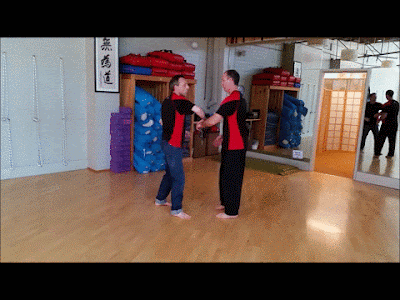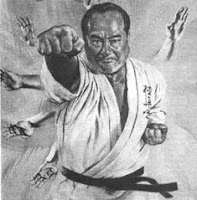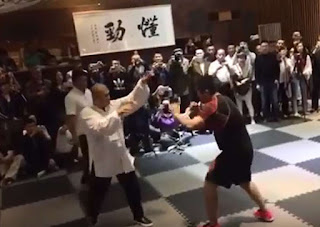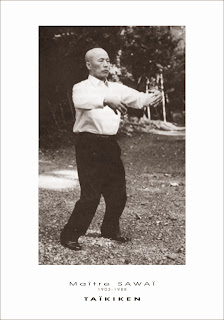Taiji qin na duels 2: slanting flying vs cloud hands
Introduction
In my previous installment, I described how one taiji technique (cloud hands) could disrupt another (repulse monkey). But does it end there? As it happens, absolutely not! It could go on and on - because every attack creates an opening, and taijiquan has a counter for every opening.
Just to show you what I mean, I'm going to take it one step further: how the move known as "slanting flying" can defeat cloud hands (after it has defeated repulse monkey!).
Slanting flying as a solo technique
Before I get to the application, I'll describe how the "slanting flying" technique is performed in the taijiquan long form (at least, in its Chen Pan Ling variation):
Slanting flying occurs in the second and third sections of the taijiquan form. I'm going to examine its iteration as it emerges from repulse monkey (because that is the application we've been looking at!).
As you finish repulse monkey, your left (back) leg immediately comes up to your front. Simultaneously, your left hand lifts, as if clearing an invisible obstacle over your left shoulder. This has quite an important function, as you'll soon see.
As your back foot comes up to join the front into a "chicken stance" (sort of a cat stance, but very short, with your front foot balancing on the tip of the big toe), your left hand comes from its high position and dives down directly to the inside of your left knee while your right hand guards to the side.
From there, you explode outwards into a 50/50 stance, throwing your left arm up to shoulder height, your left hand tilting upwards at the last second. Simultaneously, your right arm gets thrown back in line with your back leg. The wrist tilts in sympathy with your other hand as you complete the move.
Slanting flying as an antidote to the cloud hands lock
Okay, so let's see how slanting flying works against a "cloud hands lock". In order to do this, we need to start with the "wrist out turn" form "repulse monkey". Jeff grabs my label...
... and I turn his wrist out...
... and apply the wrist out turn.
Jeff responds by rolling around, using the cloud hands method to seize control of my pressing arm.
Jeff is about to take me into a lock when I step up and ram my left leg behind his right knee, destablising his balance. At the same time, after an initial raise to create a counter response (the lift over the imaginary obstacle in the solo form) I drive my left hand deep and low to the ground, wedging Jeff's right arm and dislodging his hold. I aid this process by using my right hand to ward Jeff off at his right shoulder.
Having dislodged his grip and unbalanced him, I use my coiled up energy to spring upwards, using my left (lead) arm to lever under Jeff's arms. Simultaneously I extend my left leg behind Jeff's legs, my right arm hooks behind Jeff's right knee to provide an anchor point and I throw Jeff up and behind me.
Slanting flying as an antidote to a hip throw
Using the same principle, you will find that slanting flying is very useful against a variety of grappling techniques, particularly ones that rely on close quarter levers. The hip throw is one such technique. Using more or less the identical method, slanting flying provides an excellent antidote to the hip throw - provided you engage it early enough.
 In this regard I reminded of the late Jan de Jong, master of jujutsu, who once answered my question: "What would you do if I applied this lock to you?" His answer:
In this regard I reminded of the late Jan de Jong, master of jujutsu, who once answered my question: "What would you do if I applied this lock to you?" His answer:
I go through all the above applications in some detail in the video below:
Slanting flying as an antidote to wrist out turn
On the other hand you could avoid the whole "cloud hands" response to a wrist out turn and go straight to slanting flying!
You can see a fuller exposition of the above technique and others in the video below:
Copyright © 2015 Dejan Djurdjevic
In my previous installment, I described how one taiji technique (cloud hands) could disrupt another (repulse monkey). But does it end there? As it happens, absolutely not! It could go on and on - because every attack creates an opening, and taijiquan has a counter for every opening.
Just to show you what I mean, I'm going to take it one step further: how the move known as "slanting flying" can defeat cloud hands (after it has defeated repulse monkey!).
Slanting flying as a solo technique
Before I get to the application, I'll describe how the "slanting flying" technique is performed in the taijiquan long form (at least, in its Chen Pan Ling variation):
Slanting flying occurs in the second and third sections of the taijiquan form. I'm going to examine its iteration as it emerges from repulse monkey (because that is the application we've been looking at!).
As you finish repulse monkey, your left (back) leg immediately comes up to your front. Simultaneously, your left hand lifts, as if clearing an invisible obstacle over your left shoulder. This has quite an important function, as you'll soon see.
As your back foot comes up to join the front into a "chicken stance" (sort of a cat stance, but very short, with your front foot balancing on the tip of the big toe), your left hand comes from its high position and dives down directly to the inside of your left knee while your right hand guards to the side.
From there, you explode outwards into a 50/50 stance, throwing your left arm up to shoulder height, your left hand tilting upwards at the last second. Simultaneously, your right arm gets thrown back in line with your back leg. The wrist tilts in sympathy with your other hand as you complete the move.
Slanting flying as an antidote to the cloud hands lock
Okay, so let's see how slanting flying works against a "cloud hands lock". In order to do this, we need to start with the "wrist out turn" form "repulse monkey". Jeff grabs my label...
... and I turn his wrist out...
... and apply the wrist out turn.
Jeff responds by rolling around, using the cloud hands method to seize control of my pressing arm.
Jeff is about to take me into a lock when I step up and ram my left leg behind his right knee, destablising his balance. At the same time, after an initial raise to create a counter response (the lift over the imaginary obstacle in the solo form) I drive my left hand deep and low to the ground, wedging Jeff's right arm and dislodging his hold. I aid this process by using my right hand to ward Jeff off at his right shoulder.
Having dislodged his grip and unbalanced him, I use my coiled up energy to spring upwards, using my left (lead) arm to lever under Jeff's arms. Simultaneously I extend my left leg behind Jeff's legs, my right arm hooks behind Jeff's right knee to provide an anchor point and I throw Jeff up and behind me.
Slanting flying as an antidote to a hip throw
Using the same principle, you will find that slanting flying is very useful against a variety of grappling techniques, particularly ones that rely on close quarter levers. The hip throw is one such technique. Using more or less the identical method, slanting flying provides an excellent antidote to the hip throw - provided you engage it early enough.
 In this regard I reminded of the late Jan de Jong, master of jujutsu, who once answered my question: "What would you do if I applied this lock to you?" His answer:
In this regard I reminded of the late Jan de Jong, master of jujutsu, who once answered my question: "What would you do if I applied this lock to you?" His answer:"What would you do if I punched you in the face? Once a technique is properly applied, the time for an "antidote" is over. You need to intercept it before it is properly applied. After that it is too late - whether it is a punch or a lock. Both are attacks. You have to intercept attacks before they land. Just because it is a "lock" and not a strike makes not one iota of a difference."In this case, you have to execute the slanting flying method just before a technique (usually a throw) is being applied to you - not after.
I go through all the above applications in some detail in the video below:
Slanting flying as an antidote to wrist out turn
On the other hand you could avoid the whole "cloud hands" response to a wrist out turn and go straight to slanting flying!
You can see a fuller exposition of the above technique and others in the video below:
Copyright © 2015 Dejan Djurdjevic
















Comments
Post a Comment